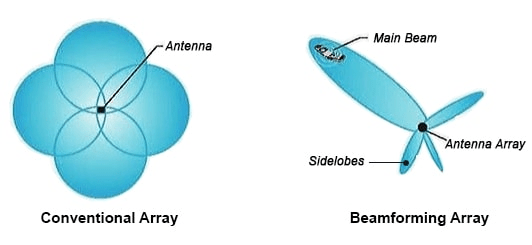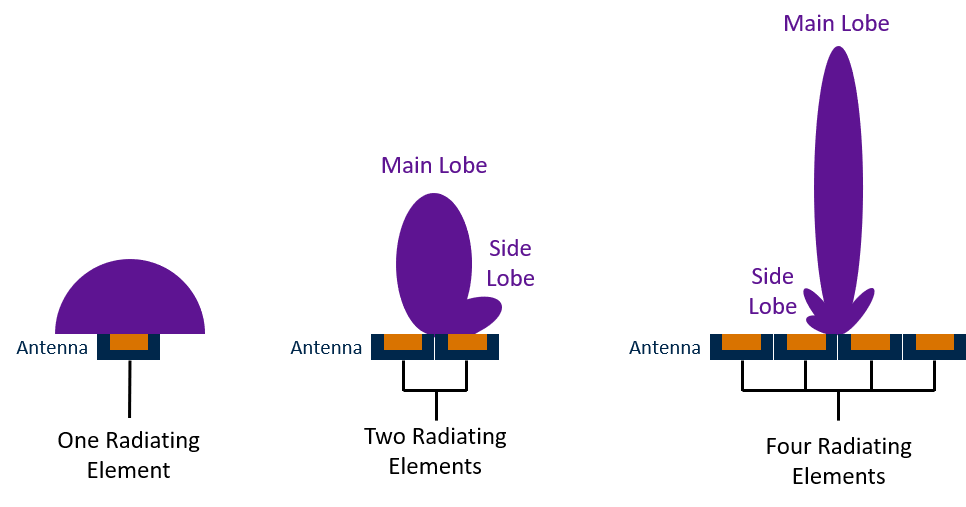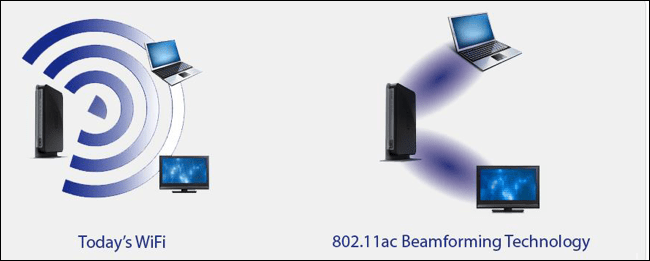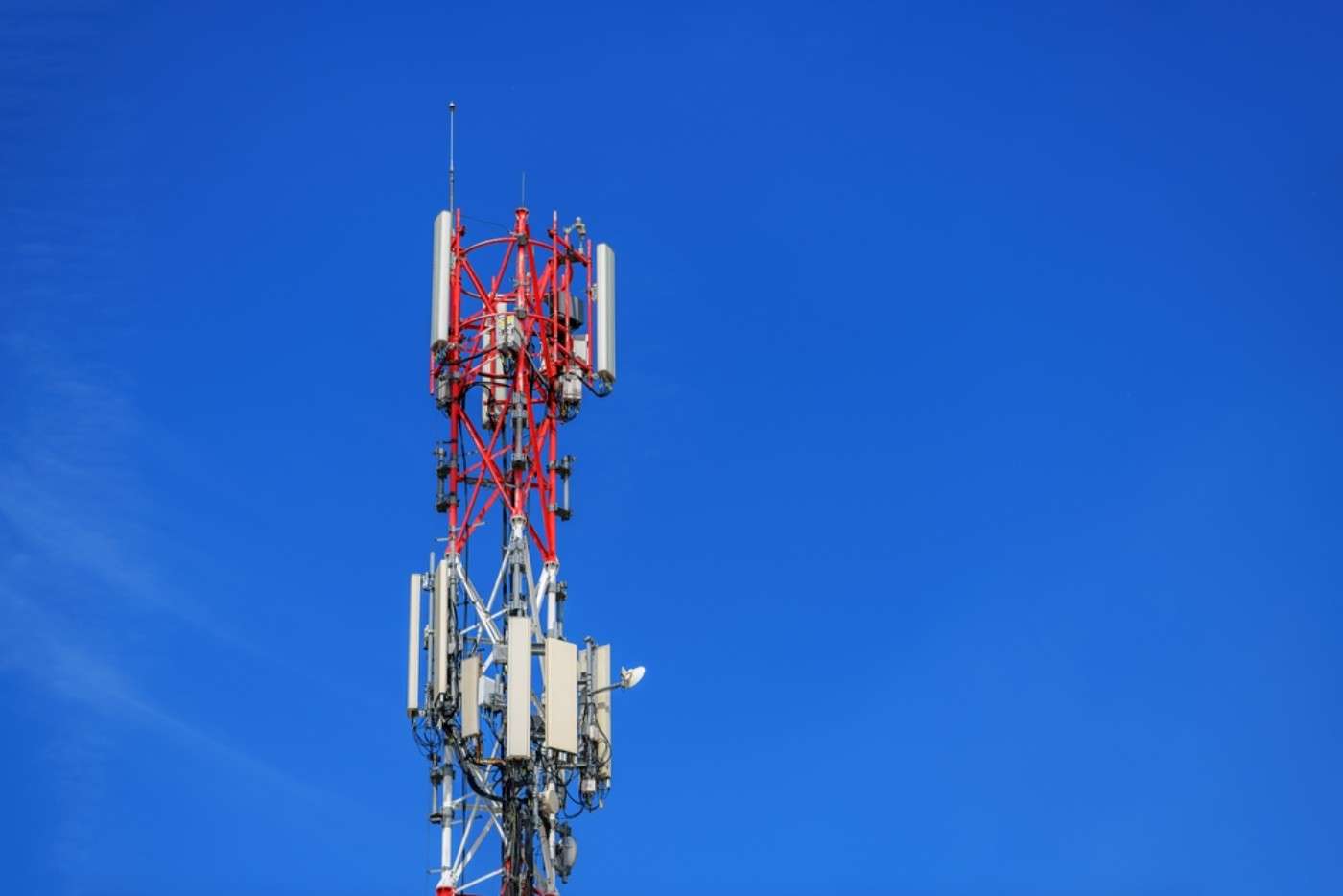Beamforming principles have been known since the 1940s, but the technology is now playing an important role in upgrading modern wireless communication protocols such as WiFi and 5G. When combined with MU-MIMO, beamforming technology provides customers with more accurate connections that increase data throughput. By focusing a signal in a certain direction, Beamforming helps improve signal quality to your receiver. Let us first define Beamforming and its advantages.
What is Beamforming?

Beamforming technology directs a wireless signal to a single receiving device rather than spreading the signal in all directions as a broadcast antenna does. With Beamforming, the direct connection that results is quicker and more dependable.
Signals from a single antenna radiate in all directions until prevented by a physical object, which is the nature of electromagnetic waves. Antenna arrays nearby broadcast the same signal at different times to focus the signal in a certain direction, forming a focused beam of electromagnetic energy. Interference will be produced by the overlapping waves, which will be constructive in some locations (making the signal stronger) and destructive in others (causing the signal to weaken).
The mathematics underpinning beamforming is quite tricky, yet beamforming techniques are not new. Beamforming technology methods may benefit any energy that moves in waves, including sound; they were initially created to enhance sonar during World War II and are used in audio engineering today.
Your signal will be powerful and concentrated if Beamforming is done correctly. However, inference and a lost signal can happen if it is not done appropriately.
How Does Beamforming Work?
Depending on the kind of implementation, Beamforming works differently. On the other hand, a beamforming tower or router may alter the signals it delivers by having numerous antennas nearby give out various signals at different times. Among the beamforming techniques are the following:
1. Analog Beamforming: A single input data stream is delivered to a collection of feedlines flowing into the phased array in analog Beamforming. A phase shift is imparted to the input signals flowing to each antenna along the route. The direction of the emitted beam is determined by the phase shift between broadcast signals supplied to each antenna.
2. Digital Beamforming: Each antenna element has its own converter. As a result, numerous beams may be captured and transmitted simultaneously without requiring accurate phase control to execute Beamforming and steering. Instead of relying on the phase difference between data streams to determine the beam steering angle, a technique known as precoding is used to integrate beams such that their superimposed transmission from all elements creates beams along multiple desired directions simultaneously.
3. Hybrid Beamforming: This is a hybrid of analog and digital beamforming techniques. To construct the patterns sent from an antenna array, the hybrid technique employs analog beamforming in conjunction with digital precoding, which is employed to allow multistream transmission. The technique limits the number of analog beams while allowing for considerable frequency fluctuation. Hybrid beamforming technology can be used in 5G base stations.

source-Beamforming with two and four radiating elements
4. Massive MIMO: MIMO (multiple-input, multiple-output) is a radio antenna technique that uses multiple antennas at both the receiver and the transmitter to improve radio connection quality, throughput, and capacity. MIMO employs spatial diversity and multiplexing techniques to send distinct and individually encoded data signals.
5. Beam Steering: Modifies the phase of input signals on every transmitting antenna element. This approach effectively follows the receiving device and directs a signal to it. A signal beam steers a common frequency in the right direction.
Beamforming in WiFi

WiFi 6, the most recent version of WiFi, was formerly known as 802.11ax. The 802.11ax protocol is the next generation after the 802.11ac standard. 802.11ac, for example, is now known as WiFi 5, while 802.11n is just WiFi 4.
While beamforming technology has existed since WiFi 4, it was improved in WiFi 5 and now in WiFi 6. To send out numerous overlapping signals, Beamforming uses MIMO technology. With the release of WiFi 5 in 2016, a standard set of beamforming algorithms for WiFi equipment allows it to interoperate vendor-independently.
Beamforming will also play an important role in WiFi 7 (also known as 802.11be), the next generation of WiFi. Coordinated Beamforming will take advantage of current multi-antenna access points’ capacity to spatially multiplex their units while cooperatively nullifying nearby non-associated stations.
While this approach may also be accomplished using a joint multi-access node sounding scheme, synchronized Beamforming can benefit from a simplified sequential sounding process that will be included in WiFi 7. Furthermore, because each station sends and receives data to and from one access point, coordinated Beamforming eliminates the need for collaborative data processing. This will result in significant performance and latency improvements while reducing complexity.
Beamforming and 5G

Beamforming is a core technology of 5G networks deployed worldwide for smartphones and other wide-area networking applications. Because 5G frequencies operate on the millimeter wavelength (mmWave), they are more susceptible to interference from things such as walls and other obstacles. Beamforming 5G may also harness the diversity and multiplexing advantages of MIMO-based transmission to give faster throughput and more reliable signal reception at the receiver, resulting in a better user experience overall.
Beamforming 5G enables service providers to build 5G connections that focus more on a receiving device. A typical 5G small cell, for example, that does not use Beamforming during its MIMO transmission would be unable to tightly concentrate or focus its transmit beams to a specific location. Instead, the tiny cell can use Beamforming to guide transmission toward a mobile device such as a cell phone, laptop, self-driving car, or IoT node. This enhances overall network efficiency and saves electricity.
Beamforming in 5G will also be compatible with massive MIMO, a technique in which a huge number of antennas at a 5G base station guide beams to user devices vertically and horizontally to boost throughput and efficiency.
Benefits and Challenges of Beamforming
Beamforming technology has the apparent advantage of allowing for a more direct connection between a receiver and a transmitter. In wireless communication, this correlates to greater connection and network throughput performance as measured by more stable and dependable connections and quicker data transfer.
Advantages of Beamforming
- Increases the strength of electromagnetic waves by focusing them in a single beam, expanding a signal’s travel potential.
- Because signals are focused on specific and targeted locations, it minimizes frequency interferences from nearby electromagnetic radiation from other sources.
- Improves data transfer speeds and efficiency while reducing mistakes by assuring improved signal quality transmission.
- Because of focused communication and decreased frequency noise, it is possible to connect to a single base station, router, or source several times.
- Enhances the efficiency of cellular network technologies such as 4G LTE and LTE Advanced, real 4G standard, and 5G technologies while increasing end-user experience.
Disadvantages of Beamforming
- High implementation costs increase the network infrastructure cost and the cost of producing end-user devices or goods.
- This approach also necessitates using powerful digital signal-processing circuits, which raises the implementation cost even further.
- Concerns about energy efficiency since omnidirectional broadcasting and telecommunication use significantly more electricity.
- Due to Beamforming’s power-hungry and processing-intensive requirements, end-user devices would demand greater battery capacity.
- Reduced network coverage because signals flow in a line-of-sight form, requiring a user to be positioned along the beam’s direction.
Beamforming: Considerations
Consider the following before implementing Beamforming:
- Beamforming in 5G is an ambitious concept for utilizing a considerably larger share of the electromagnetic spectrum, particularly at higher frequencies. It necessitates a significantly higher and wider bandwidth, previously unused (and so untested) frequencies. Larger bandwidths necessitate tests that span a broader range of frequencies at which a device may function, necessitating more complex testing equipment.
- Testing at high frequencies is frequently difficult owing to substantial path loss. Whether traveling through air or down a transmission line, the distance traveled by the RF signal at millimeter-wave frequencies incurs significant insertion loss. Testing devices and multipurpose integrated circuits at 5G frequencies will necessitate innovative packaging, tight controls, and testing subsystems to minimize RF signal loss and preserve RF signal integrity over long distances.
- Multiple frequencies and many antenna components can add up to a high cost.
- Digital Beamforming necessitates transceivers for each antenna, which raises costs due to greater power consumption.
- MIMO systems and beamforming techniques need help understanding.
- Because they impact performance, antenna performance, and beam characteristics, carefully evaluate beam management algorithms before choosing.
- Consumer-facing equipment, like routers, can be costly, ranging from $90 to $350.
The Future of Beamforming
Beamforming technology has the potential to become increasingly prevalent in WiFi and 5G networks, and it can assist communication networks in meeting future data rates and network capacity. Furthermore, when beamforming algorithms develop, it will be able to pick the optimum data pathways.
In addition to network base stations and wireless network routers, the technology may be found in various end-use communication devices, including cell phones, personal computers, and other smart consumer electronic gadgets.
Radar detection systems have also used Beamforming. Previous radar technologies required moving, steering, transmitting, and receiving parabolic antennas to aim in the desired direction. Signal processing techniques decrease the need for physical movements and reliance on the physical construction of antennas by modifying radio waves and directing them as a focused beam of an electromagnetic wave toward a specific spot.
Businesses nowadays are looking for new methods to develop and achieve their objectives. This industry will continue to expand in the future, thanks to Beamforming. It’s a powerful and expansive technology that will continue to evolve and give several benefits in the future.
FAQs
1. What is the relation between Beamforming and Massive MIMO?
Massive MIMO (mMIMO) and Beamforming are jargon commonly used in the telecom industry when discussing 5G and the latest LTE advances. The difficulty is that MIMO comes in many distinct flavors, some of which have been used in legacy LTE networks for years.
Put another way, Beamforming is employed in mMIMO or is a subset of mMIMO. In general, Beamforming controls the direction of a wavefront by suitably balancing the amplitude and phase of individual antenna signals in a multi-antenna array. The same signal is broadcast from several antennas separated by sufficient space.
2. What is Beam Steering?
Beam steering is a 5G network technology for directing radio waves to a specified target, such as a user’s device. The 5G network can deliver a more efficient and stable connection by directing the beam.
This beam steering allows for various angle and/or multiple point examination with a single probe and single probe location. Beam steering is a technique used in acoustics to guide music from loudspeakers to a specified position in the listening area. This is accomplished by adjusting the amplitude and phase of two or more loudspeakers positioned in a column, where the blended sound is added and canceled at the desired location.
Beam steering in optical systems can be achieved by modifying the material’s refractive index through which the beam is transmitted or by using mirrors, lenses, prisms, or rotating diffraction gratings.
3. What is the difference between Beamforming and Spatial Multiplexing?
Beamforming technology is a cutting-edge antenna technique made possible by MIMO antenna systems. Without MIMO technology, radio signals transmitted by base station antennas travel in all directions within the cell radius in conventional base stations. Beamforming introduces directivity, allowing cellular base stations to aim signal transmission in certain directions.
The fundamental rationale for employing MIMO technology in 4G LTE networks is spatial multiplexing, which allows MIMO to give faster data rates. In addition, MIMO benefits from spatial multiplexing to increase signal quality and network range. Therefore, spatial multiplexing is a crucial component of MIMO in 4G LTE and 5G NR networks.
4. What is Analog Beamforming?
A single signal is delivered to each antenna element in the array in analog Beamforming by sending it through analog phase shifters, which are amplified and routed to the desired receiver. The analog signal is subjected to amplitude/phase fluctuation at the transmit end, where signals from many antennas are combined before Analog to Digital (ADC) conversion. Analog beamforming is currently the most cost-effective approach to creating a beamforming array. However, it can only manage and generate one signal beam.















